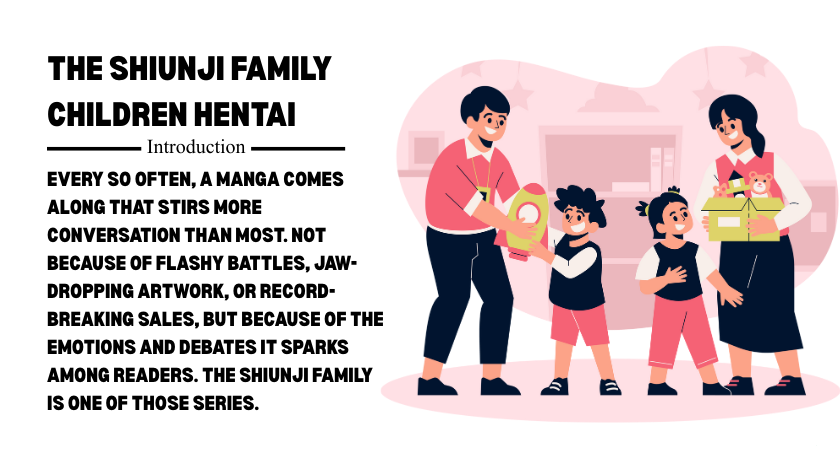
Every so often, a manga comes along that stirs more conversation than most. Not because of flashy battles, jaw-dropping artwork, or record-breaking sales, but because of the emotions and debates it sparks among readers. The Shiunji Family is one of those series.
When I first heard about this manga, it wasn’t from an official publication or even a bookstore shelf. It was through online chatter—people debating whether it was genius satire, an awkward experiment, or something too controversial to touch. That alone made me curious. Why did this series draw such divided reactions?
On the surface, The Shiunji Family looks like another slice-of-life manga about an unusual household. But once you dive in, you realize it’s far from ordinary. The story mixes comedy, eccentric character interactions, and topics that can make readers uncomfortable. Some find it refreshing and bold. Others see it as problematic or simply confusing.
In this article, I’ll take you through everything you need to know about The Shiunji Family: its origins, the characters, the central themes, and the reasons behind its controversies. Along the way, I’ll share my own impressions, point out cultural nuances that often get lost in translation, and suggest alternatives if you’re looking for something lighter or more straightforward.
Whether you’re here because you’ve heard whispers about this manga, or you stumbled across the name while browsing anime forums, this deep dive will give you a clearer picture of what The Shiunji Family is all about.
Background of The Shiunji Family
To understand the appeal and criticism surrounding The Shiunji Family, we need to start with the basics: where it came from, who created it, and how it ended up in so many online discussions.
Origins and Publication
The Shiunji Family is a Japanese manga that began circulating in the last decade. While not one of the mainstream juggernauts like Naruto or Attack on Titan, it carved out a niche following. Its notoriety didn’t come from mass publication but rather from word of mouth, internet forums, and translations that spread among dedicated manga communities.
Like many niche titles, it benefited from the rise of digital sharing. Readers curious about unique or controversial series sought it out, discussed it in fan groups, and debated its intentions. This underground popularity helped The Shiunji Family gain traction, even if it never reached the same commercial heights as more family-friendly manga.
Story Overview
At its heart, the manga focuses on the Shiunji household, a family that is anything but ordinary. On paper, it’s a story about family life, but the dynamics within the home are quirky, exaggerated, and sometimes intentionally uncomfortable. The comedy is layered with moments that test the line between absurd humor and social commentary.
One of the most interesting things about the manga is how it constantly shifts tone. You’ll find lighthearted jokes in one chapter, only to be hit with something that feels much darker or more controversial in the next. This unpredictability is one of the reasons it draws attention. Some readers love this rollercoaster effect, while others feel it tries too hard to shock.
First Impressions
When I first read the early chapters, my initial reaction was confusion. Was it supposed to be a satire of traditional Japanese family life? A parody of manga tropes? Or was it simply designed to provoke?
Over time, I realized it’s a bit of all three. The Shiunji Family doesn’t sit comfortably in any single genre. It borrows from slice-of-life, comedy, and drama, but it also includes elements that make readers question the characters’ relationships and motivations.
The Characters and Their Dynamics
One of the most fascinating aspects of The Shiunji Family is how the characters interact with one another. Unlike conventional manga families, where roles are clear-cut and relationships follow familiar patterns, the Shiunji household feels chaotic, unpredictable, and sometimes uncomfortably close. This is intentional. The author seems to want readers to constantly question the boundaries of family life, humor, and propriety.
Let’s look at the main players and how they shape the story.
The Parents
In many family-centered manga, the parents either fade into the background or serve as steady, reliable figures. Not here. In The Shiunji Family, the parents are eccentric in their own right.
-
The Father: He’s portrayed as aloof, sometimes clueless, and occasionally the butt of jokes. What’s interesting is how he’s neither the strong patriarch nor the absent nonentity we see in other manga. Instead, he drifts in and out of the story, contributing odd remarks or strange behavior that add to the family’s chaotic vibe.
-
The Mother: She holds a more central role, but not in the traditional nurturing sense. Her actions are exaggerated, often comedic, and occasionally raise eyebrows. She can swing between caring and uncomfortably intense, which keeps readers guessing about her true intentions.
My take: I found the portrayal of the parents both funny and unsettling. They’re not there to guide the children or teach lessons. Instead, they act almost like additional wild cards, amplifying the family’s dysfunction rather than balancing it out.
The Children
The children are where the manga’s eccentricity really shines. Each one has an over-the-top personality trait that drives both the humor and the tension in the story.
-
The Eldest Child: Often depicted as the most responsible, but also the most conflicted. They sometimes try to impose order, but their efforts usually backfire. I found this character relatable because they echo the “oldest sibling” experience many of us know—trying to hold everything together, even when it’s impossible.
-
The Middle Child(ren): The middle siblings are where the comedy gets strange. Their quirks range from bizarre hobbies to exaggerated rivalries. At times, their interactions felt like a parody of classic manga sibling dynamics. For example, a simple argument over dinner might spiral into absurd antics.
-
The Youngest: Typically the most unpredictable, the youngest sibling embodies innocence on the surface but often delivers the most shocking or unexpected lines. They’re like the wildcard that makes every scene feel unstable.
Observation: What’s unusual is how the children’s relationships with each other occasionally blur the lines between comedy and something more controversial. This is where many readers feel conflicted. Is it just exaggerated humor? Or is it deliberately pushing boundaries to provoke thought—or even discomfort?
Extended Family and Supporting Cast
No manga family exists in a vacuum, and The Shiunji Family introduces extended relatives and outsiders who interact with the core household. These side characters often highlight how unusual the Shiunji family really is.
-
Neighbors often serve as the “normal” foil, reacting with shock or confusion at the Shiunji family’s antics.
-
Relatives who visit occasionally either blend into the chaos or serve as plot devices to stir things up further.
-
School friends add another perspective, sometimes acting as stand-ins for the reader, openly questioning the family’s odd behavior.
Personal note: I found myself sympathizing most with the outsiders. Watching them try to make sense of the Shiunji family felt like a mirror of my own reading experience—equal parts fascinated and bewildered.
Why the Characters Work (and Don’t)
The beauty and the flaw of The Shiunji Family characters is the same: they are extreme.
-
On one hand, their exaggerated quirks make for entertaining, unpredictable storytelling. You never know what’s coming next, which keeps the manga from being boring.
-
On the other hand, their interactions sometimes feel designed purely to shock or unsettle, rather than to build meaningful development.
For me, the characters were both the highlight and the barrier. They’re memorable, yes, but they also made it hard to recommend the manga to casual readers who prefer smoother, less provocative narratives.
Themes and Symbolism in The Shiunji Family
Beneath the surface-level comedy and chaotic family antics, The Shiunji Family explores a number of themes that go far beyond ordinary slice-of-life manga. Some of these themes resonate with cultural traditions, while others feel deliberately subversive. Whether you find the manga clever or troubling often comes down to how you interpret these recurring ideas.
Family Relationships in Japanese Culture
Family is one of the most common themes in Japanese media. From heartwarming series like Clannad to deeply dramatic ones like March Comes in Like a Lion, family often symbolizes stability, support, and identity.
But The Shiunji Family twists this idea. Instead of a picture-perfect household, it gives us dysfunction and exaggeration. Parents aren’t authority figures, children don’t behave predictably, and relationships don’t follow the comforting path you might expect.
Symbolic angle:
-
The manga seems to parody the concept of the “ideal Japanese family,” showing us a household where norms are flipped upside down.
-
Rather than being a safe space, the Shiunji home is a stage for chaos.
Personal take: When I first read it, I felt like the author was making fun of the idea that any family is truly “perfect.” Behind every front door, there are quirks, secrets, and struggles. The Shiunji family is just an extreme version of that reality.
Comedy vs. Darker Undertones
On the surface, many of the scenes are comedic. Silly arguments, exaggerated sibling rivalry, and absurd family rituals are presented with humor. But just beneath that, there’s often an uneasy undertone.
For example:
-
A joke that starts funny might escalate into something that feels mean-spirited.
-
A character’s “quirky” habit may come across as more troubling than amusing.
-
Situations that look playful at first can leave readers asking, “Wait, was that supposed to be okay?”
This blend of comedy and discomfort is intentional. It forces readers to think about where the line between humor and harm lies.
Observation: Personally, I laughed at some of the exaggerated family squabbles, but there were moments that made me pause and feel uneasy. That tension is part of what makes the series so memorable, even if it’s not always enjoyable.
Satire, Parody, or Social Commentary?
A big question surrounding The Shiunji Family is whether it’s meant to be satire.
-
Satire: If you view it this way, the manga is poking fun at Japanese family stereotypes, manga tropes, and even the way audiences consume media.
-
Parody: Others see it as a parody of “family comedy” manga, taking clichés and cranking them up to absurd levels.
-
Social Commentary: Some readers argue that it’s holding up a mirror to real-life issues—like generational disconnect, lack of boundaries, or the way families present themselves in public versus private.
The truth might be a mix of all three.
Personal perspective: For me, the satire angle makes the most sense. The manga often exaggerates everyday family situations to the point where you can’t take them seriously. But in doing so, it also reveals how fragile and strange our “normal” expectations can be.
Recurring Motifs
Beyond the big themes, there are smaller motifs that pop up repeatedly in The Shiunji Family. These include:
-
Meals: Family dinners are supposed to bring people together, but in this manga, they often spiral into absurdity. Symbolically, it suggests that even the most ordinary family moments can reveal hidden dysfunction.
-
Boundaries: Characters frequently cross personal boundaries, sometimes for laughs, sometimes in ways that make readers uncomfortable. This motif reinforces the theme of blurred lines between intimacy and intrusion.
-
Chaos vs. Order: One sibling might try to enforce order, only to be swallowed up by the family’s overwhelming chaos. It’s almost like the manga is saying: “In families, no one is really in control.”
My observation: These motifs reminded me of my own family dinners growing up. Of course, nothing as extreme as what happens in the Shiunji household, but even in real life, the dinner table can be both bonding and explosive.
Why the Themes Matter
Even if you find The Shiunji Family too strange or unsettling, the themes it raises are worth considering. They ask us to think about:
-
What makes a family “normal”?
-
How much dysfunction is just part of everyday life?
-
When does humor stop being funny and start being harmful?
By exaggerating these questions through bizarre characters and wild situations, the manga creates space for reflection—even if it does so in a way that’s not comfortable for everyone.
Frequently Asked Questions (FAQs) about The Shiunji Family
Q1: What is The Shiunji Family manga about?
It’s a story centered on the quirky, chaotic, and sometimes unsettling dynamics of the Shiunji household. On the surface, it looks like a comedy about family life, but it often mixes humor with controversial or thought-provoking situations.
Q2: Is The Shiunji Family appropriate for all readers?
Not really. While it’s not as graphic as some manga, it does include themes and character interactions that may feel uncomfortable for younger or casual readers. It’s best suited for people who enjoy unconventional storytelling and don’t mind satire that pushes boundaries.
Q3: Why is The Shiunji Family considered controversial?
The controversy comes from how it blurs the line between comedy and discomfort. Some readers see it as clever satire, while others feel it goes too far in exaggerating family relationships. Different cultural perspectives also affect how people interpret the story.
Q4: Is there an anime adaptation of The Shiunji Family?
As of now, no major anime adaptation exists. Most of the attention comes from the manga itself and the discussions it sparks in online communities.
Q5: What are some similar manga or anime I could read instead?
If you want something family-centered but less controversial, consider:
-
Clannad – A heartfelt story about family, loss, and growth.
-
Usagi Drop – A touching tale about unexpected parenthood.
-
March Comes in Like a Lion – A powerful look at family, depression, and resilience.
Q6: Should I read The Shiunji Family?
That depends on your taste. If you enjoy satire, unusual character dynamics, and don’t mind a bit of discomfort, it might be worth checking out. If you prefer more traditional or heartwarming family stories, you may want to look elsewhere.
Conclusion: My Final Thoughts on The Shiunji Family
Reading The Shiunji Family was a strange experience for me. At first, I wasn’t sure if I was supposed to laugh, cringe, or analyze it like a piece of satire. In the end, I realized it was all three. The manga intentionally keeps you off balance, forcing you to question what “family” really means, what counts as funny, and why we find dysfunction so compelling to watch.
I wouldn’t call it a masterpiece, but I also wouldn’t dismiss it outright. It’s the kind of story that sticks in your mind precisely because it doesn’t play it safe. Whether you find it thought-provoking or off-putting, it will leave an impression.
For me, the takeaway is this: every family has quirks, and sometimes those quirks are exaggerated, messy, and even uncomfortable. The Shiunji Family pushes that reality to the extreme, reminding us that “normal” is a lot stranger than we think.
Would I recommend it to everyone? No. But if you’re curious about unusual manga that blends comedy, satire, and controversy, it’s worth giving a try. Just go in with an open mind—and maybe a willingness to be uncomfortable at times.







